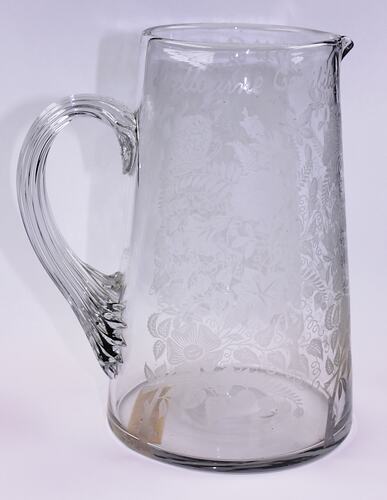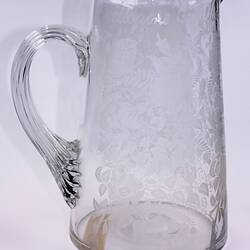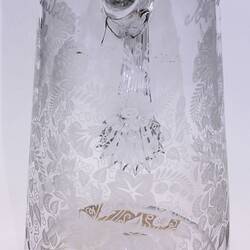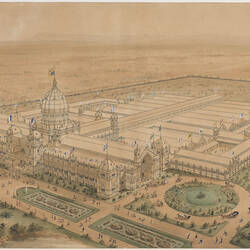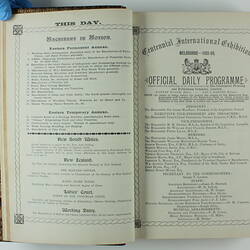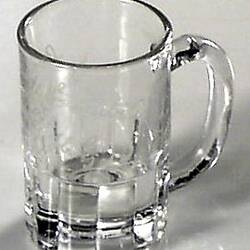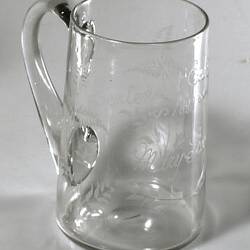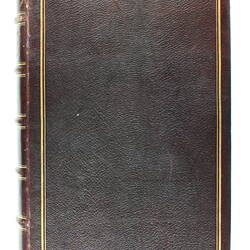Summary
Glassware displays and glassware engraving at the Melbourne Centennial International Exhibition (MCIE) were held in the British Court and gained rave reviews in the popular press. The British Court was one of the largest exhibits showcased at the MCIE, with 22 glass manufacturers displaying their goods. Most popular was the glass engraving where visitors could purchase engraved glassware as a souvenir of their time spent at this marvellous exhibition.
The British Court
The 1888 Melbourne Centennial International Exhibition (MCIE), celebrating a century of Australian settlement, was held at the (Royal) Exhibition Building, Melbourne, with nearly 40 countries sending their exhibits and approximately 2 million visits over a six month period. The British Court was one of the largest exhibits showcased at the MCIE. As it was the first exhibit on the left hand side of the Avenue of Nations, the eye of the visitor was caught at once by the magnificent display of cut and engraved glass (The South Australian Advertiser, 1888, p. 6).
British Glassware Exhibits
The British glassware exhibits gained rave reviews in the popular press. There were 22 glass manufacturers displaying their goods, exhibiting glassware such as chandeliers, mirrors, table glasses, ornaments, stained glass and more (Centennial International Exhibition, 1888). Messrs. Thos. Webb and Sons of Stourbridge were reported to have made an excellent display. Included in their varied exhibit were beautiful forms of cut glass with a lighthouse attracting the most attention, described to be "one of the most admirable designs" (The Daily Telegraph, 1888, p. 3). Additionally, this section of the British Court was said to be one of the most attractive spots in the exhibition when brilliantly illuminated by the electric lights in the evening (The South Australian Advertiser, 1888, p. 6).
Also on display was an engraved Claret jug, which represented the Council of the Gods and a vase that was engraved with several scenes from Don Quixote, a Spanish novel considered to be the most influential literature from the Spanish Golden Age (Patrick, J, 2017). The etching on the glass was said to be most aesthetically pleasing (The Daily Telegraph, 1888, p. 3). Designed on another vase was the subject of the death of Socrates, while a dazzling chandelier of 10 lights showed all the colours of the rainbow creating a brilliant impression (The Daily Telegraph, 1888, p. 3). Numerous samples of glassware could also be found on a fully laid out dining table (The Daily Telegraph, 1888, p. 3).
Glass Engraving
Popular among visitors in the British and Lancashire Court was J. Holmes & Co. glass engraving. This was an activity held from 10:00am to 10:00pm throughout the duration of the exhibition. Visitors were able to purchase engraved glass as a souvenir to remember their time spent at this most extraordinary exhibition.
A beautiful tapering cylindrical, clear glass jug with a reeded-loop handle and patterns of flowers, leaves and butterflies is a unique example of the kinds of glassware that could be purchased as a souvenir at the time (Museum Victoria Collections, 2013). This engraved glass jug with a dense floral pattern and post-factory engraving around the rim was purchased by Mrs Bolden as a memento of the exhibition (Museum Victoria Collections, 2013). This jug is a charming example of the kinds of glass engraving activities that were taking place in the British Court (Museum Victoria Collections).
References
Centennial International Exhibition 1888, The Official Catalogue of Exhibits, Mason, Firth & M'Cutcheon, Melbourne.
Patrick, J 2017, Don Quixote, Encyclopaedia Britannica, 14 May, retrieved 22 April 2017 <www.britannica.com/topic/Don-Quixote-novel>'Things at the Exhibition' 1888, The Daily Telegraph, 13 September, p.3.
Museums Victoria Collections 2013, Jug - Engraved Glass, European, 1888, retrieved 11 May 2017 <https://collections.museumvictoria.com.au/items/2029241>.
'Our Special Letter' 1888, The South Australian Advertiser, 11 August, p. 6.
More Information
-
Keywords
-
Authors
-
Article types
